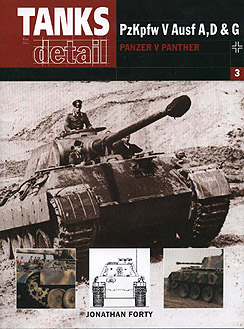| |
Tanks in Detail 3: PzKpfw V Ausf
A, D & G Panzer V Panther
by Jonathan Forty
Ian Allan Publishing Ltd, ISBN 0-7110-2941-5, 96 pages.

The third in Ian Allan’s new Tanks in Detail series covers the
famous Panther in five chapters. Chapter 1, the longest at 38 pages, deals
with design and development in a fair degree of detail. Chapter 2 deals
with the chassis, engine and tracks, chapter 3 with the fighting compartment
interior arrangements, Chapter 4 with the armament and Chapter 5 with
the markings carried.
Unfortunately Jonathan Forty has relied too much upon out-of-date reference
works and placed too much trust in old photograph captions written when
not much was known about Panthers. Just to set the record straight, Ausf
D was the first sub-type produced and was followed by A and G in that
order. The A(D1) designation he quotes never actually existed. Their distinguishing
characteristics are pointed out in the text, so look at the photographs
with those in mind and you’ll have no problems in mentally correcting
the captions. If the tank has one-piece sides it’s a G, otherwise
either D or A. If there’s a rounded, cast cupola on top of the turret
it’s an A, if the cupola is drum-shaped it’s a D. The cast
bulge on the glacis for the hull machine gun was introduced part-way through
production of the A, so it is not a way to distinguish between D and A.
Easy! The only place where these rules will let you down are page 9, where
the second prototype is captioned as an Ausf D. The prototype had a different
turret to the production tank, with a bulge to accommodate the commander’s
cupola, and was also the only Panther to had a single-baffle muzzle brake
contrary to what is stated here.
OK, those are the problems. Now for the good bits! There’s a great
selection of photographs here, including interior shots and showing many
markings. The Bergepanther recovery tank is here, and so is the Beobachtungspanther
artillery observation tank. The latter is illustrated not only with a
photo of the only one built but with interior photos showing the plotting
board and other turret interior items – excellent! The chassis,
fighting compartment and armament chapters also include many photographs
showing the interior equipment of standard Panthers, which is good news
for anyone using one of the available interior detail sets on a model.
The markings chapter gives a reasonable short analysis of the typical
tactical marking system, and includes plates showing a number of Abteilung,
Regiment, Division and Korps signs. Some of these don’t seem to
apply to Panthers, which seem rarely to have carried unit signs anyway,
but they are useful if treated as backup to distinguish the signs seen
in photographs.
All in all, despite the miscaptioned photographs and mistakes in the text
mentioned above, this is a useful low-cost reference for Panther modellers
not wanting the last word in detail.
John Prigent
|
|